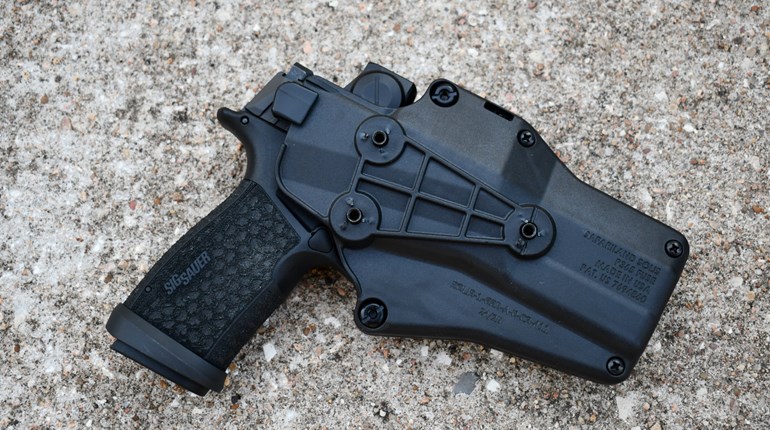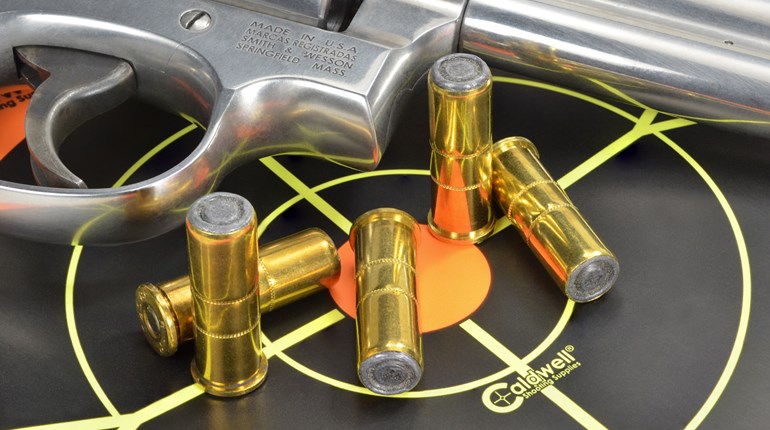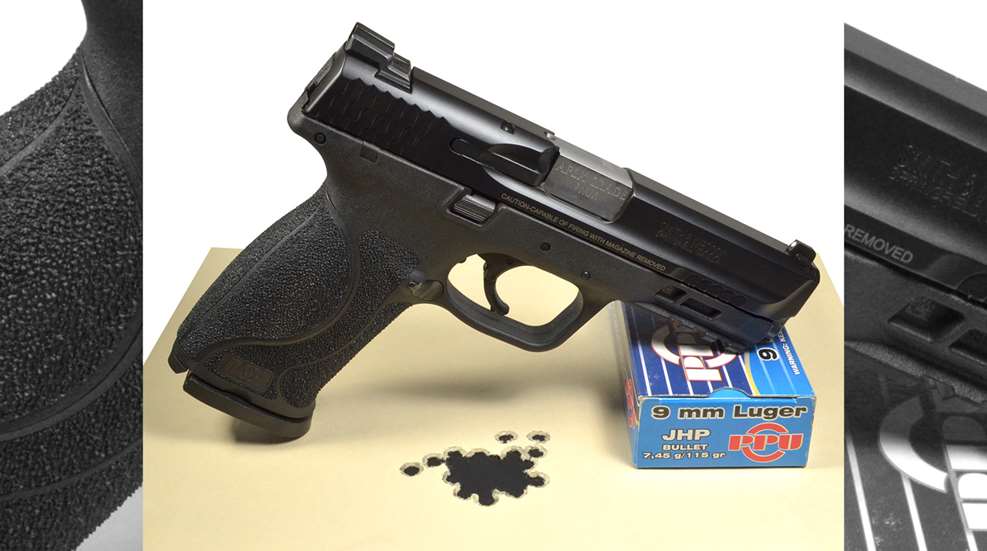
Smith & Wesson M&P semi-automatic pistols are popular for competitive shooting because of their superior ergonomics and reliability. They are sufficiently accurate for most tasks, but this does not mean that accuracy can’t be improved. A gun that shoots 3- to 5-inch groups at 25 yards is fine for self-defense, but competitive shooting demands a bit more precision.
Several companies offer aftermarket barrels for those who want to improve the accuracy of their M&P. Apex Tactical Specialties offers match-grade barrels in the Apex Grade line for M&Ps as well as other components, such as trigger kits.
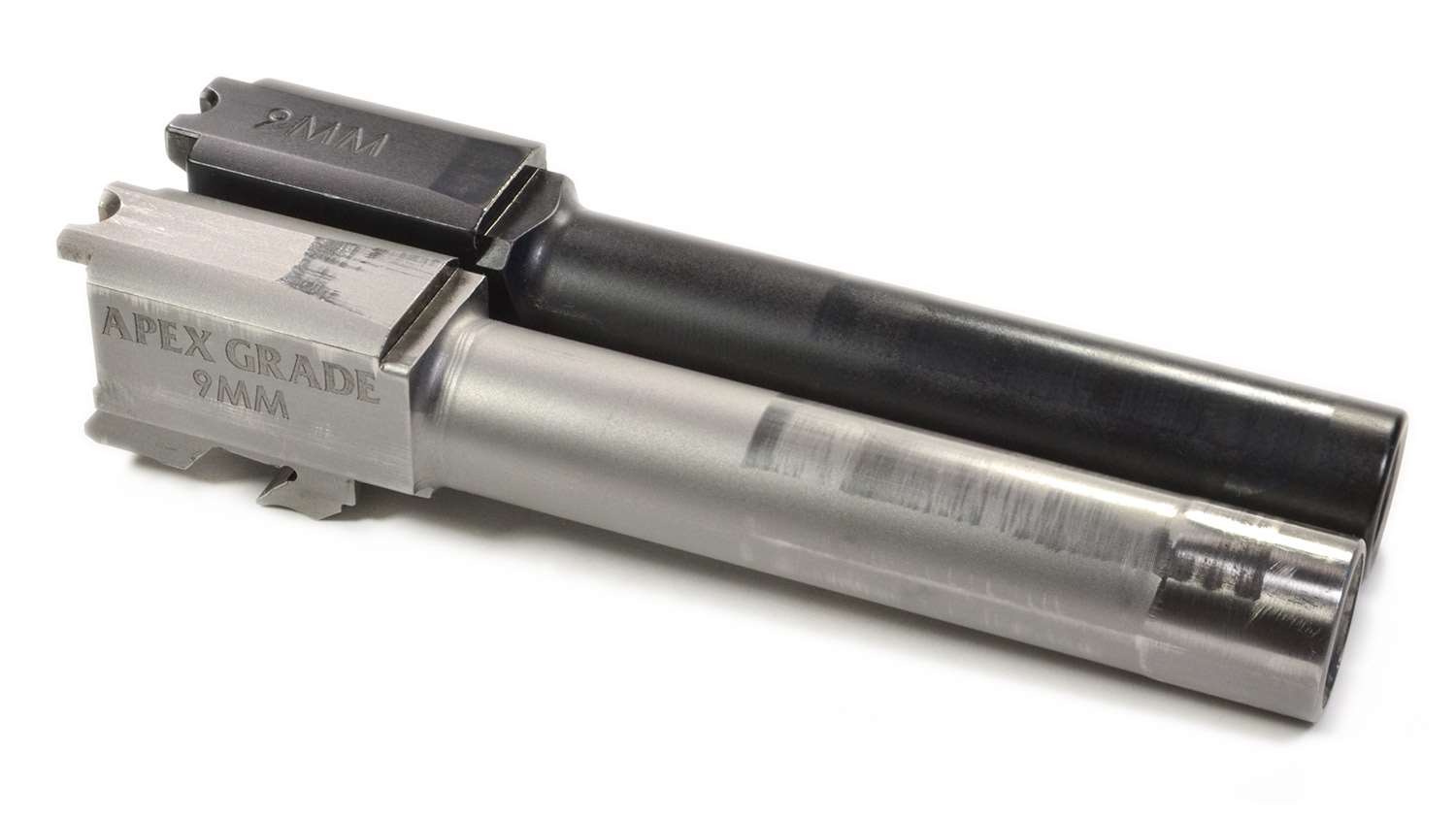
Apex Grade barrels offer better tolerances and improved timing—allowing a longer lockup (dwell) time than factory barrels. Keeping the barrel stable for a longer period should enhance mechanical accuracy.
The barrels are stainless steel and offered in 9mm only for 4.25-inch and 5-inch pistols, and fit M&P pistols including the new 2.0. They also list a 4-inch barrel for M&P compact 2.0 pistols. They sport a 1:10-inch twist and accuracy tests have shown they can produce 5-shot groups at 25 yards under 1 inch with common bullet weights like 115-, 124- and 147-grain.
I wanted to try an Apex Grade barrel in my 4.25-inch M&P9 2.0 to improve accuracy. The original Smith & Wesson barrel had a very small amount of side-to-side and front to back movement in the slide and a small amount of slop at the muzzle. It wasn’t much movement, but this is the stuff that degrades accuracy because the barrel could be in a slightly different position for each shot which would increase group size.
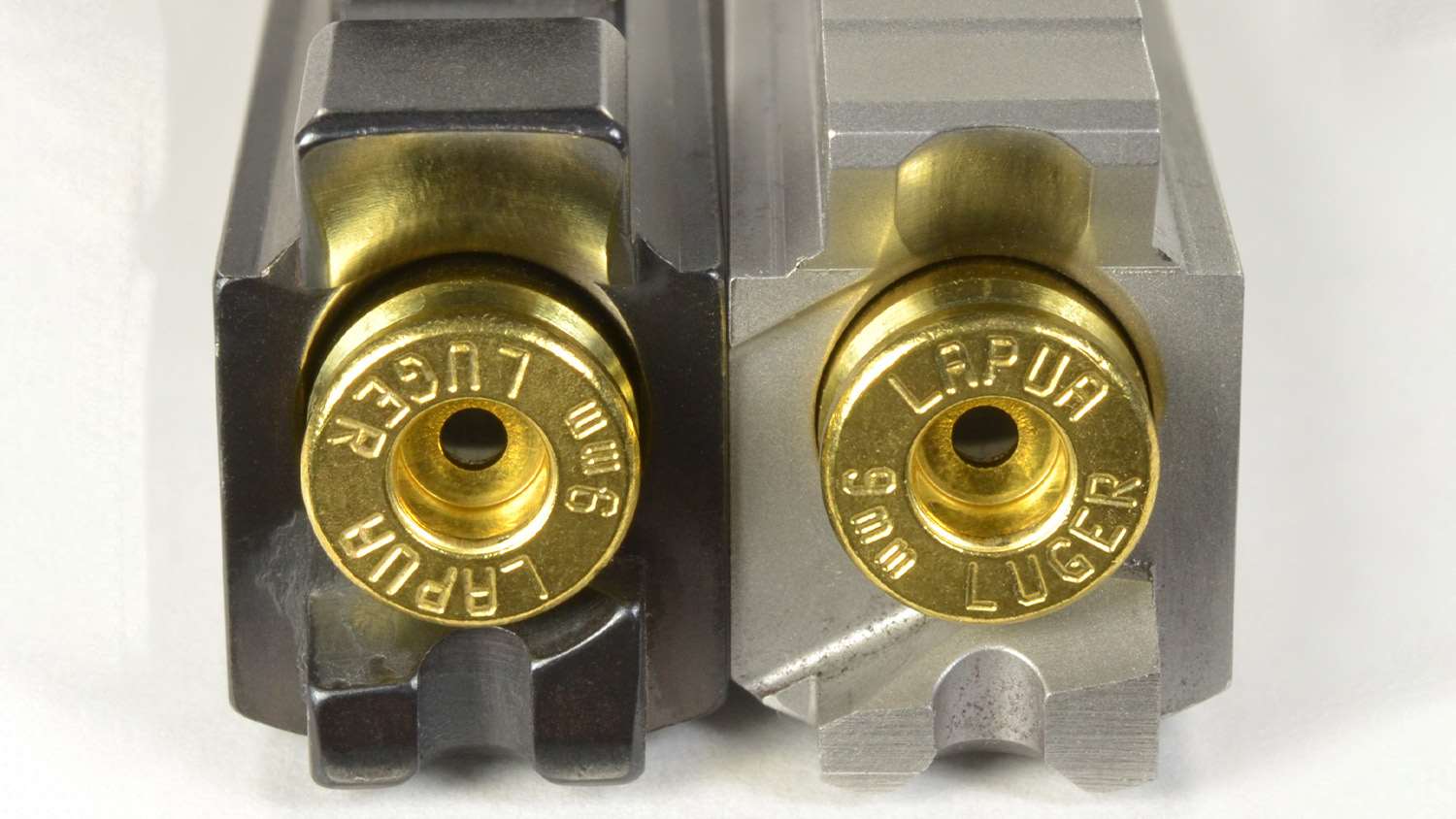
Apex barrels come in two configurations. First is a gunsmith-fit barrel, with oversize tolerances at the front of the barrel, the hood and the bottom lock-up surface. Next, a semi drop-in barrel also has oversize dimensions, but in most cases will likely require minor fitting. My first thought was to have Apex fit one of the former to my gun. At the time they were offering free fitting. However, the cost of shipping the gun both ways is expensive and including the price of the barrel was more than I could afford.
I contemplated doing this myself, as I’ve fit more than a few 1911 barrels, but the M&P is a new animal to me. After seeing where and how material needed to be removed, I wasn’t confident that I could do it without screwing it up. If too much is removed, it would be a sloppy fit—saying goodbye to match-grade accuracy.
However, I figured that if they could fit the barrel to my slide, I could handle fitting the barrel to the frame. Shipping the slide was cheap compared to shipping the gun, making this a viable project. Apex was happy to oblige me and before I knew it the new barrel and my slide arrived.
The barrel was superbly fit to the slide. When locked in the slide, there was no front-to-back or side-to-side movement at the breech. And, the barrel slid up into place without effort. At the muzzle end, there was no movement or slop in any direction. This is as good as it gets, folks.
Now the question was about fitting the bottom lock-up surface to my frame. This material must be removed evenly for a proper fit. The bottom lock-up surface pad on the drop-in barrels is narrower than on the gunsmith-fit barrels, requiring less work for a good fit. (Apex might change the size of the pad in the future.)
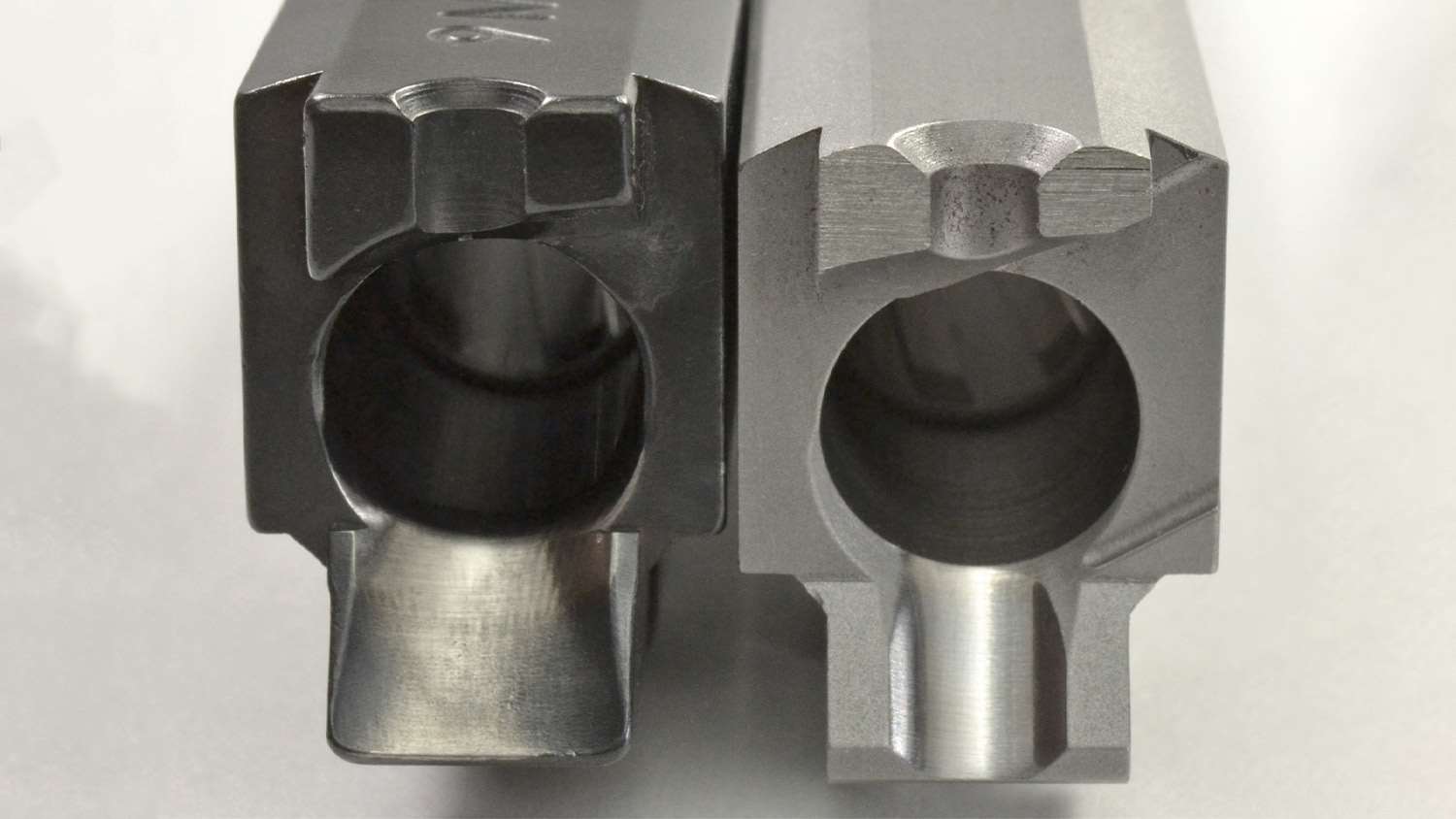
I spoke with an Apex representative about fitting the bottom lock-up surface and was told that tolerances were tight and that some guns didn’t require any material to be removed—that it would drop-in with a snug fit. Well, that turned out to describe my situation perfectly.
With the barrel in place, the slide would go all the way forward with a slight hint of resistance in the last few millimeters of travel when slowly hand cycled. When cycling the slide quickly, no resistance was evident.
According to Apex, ideally, when the slide is slowly, manually allowed to go forward, it should stop just short of full battery. It should require a little more pressure to be manually applied for it to go fully into battery. This should be no more than about 2 pounds of pressure. By this definition, my barrel fit was not as tight as it could be, but since it did have some resistance, it couldn’t be off by much.
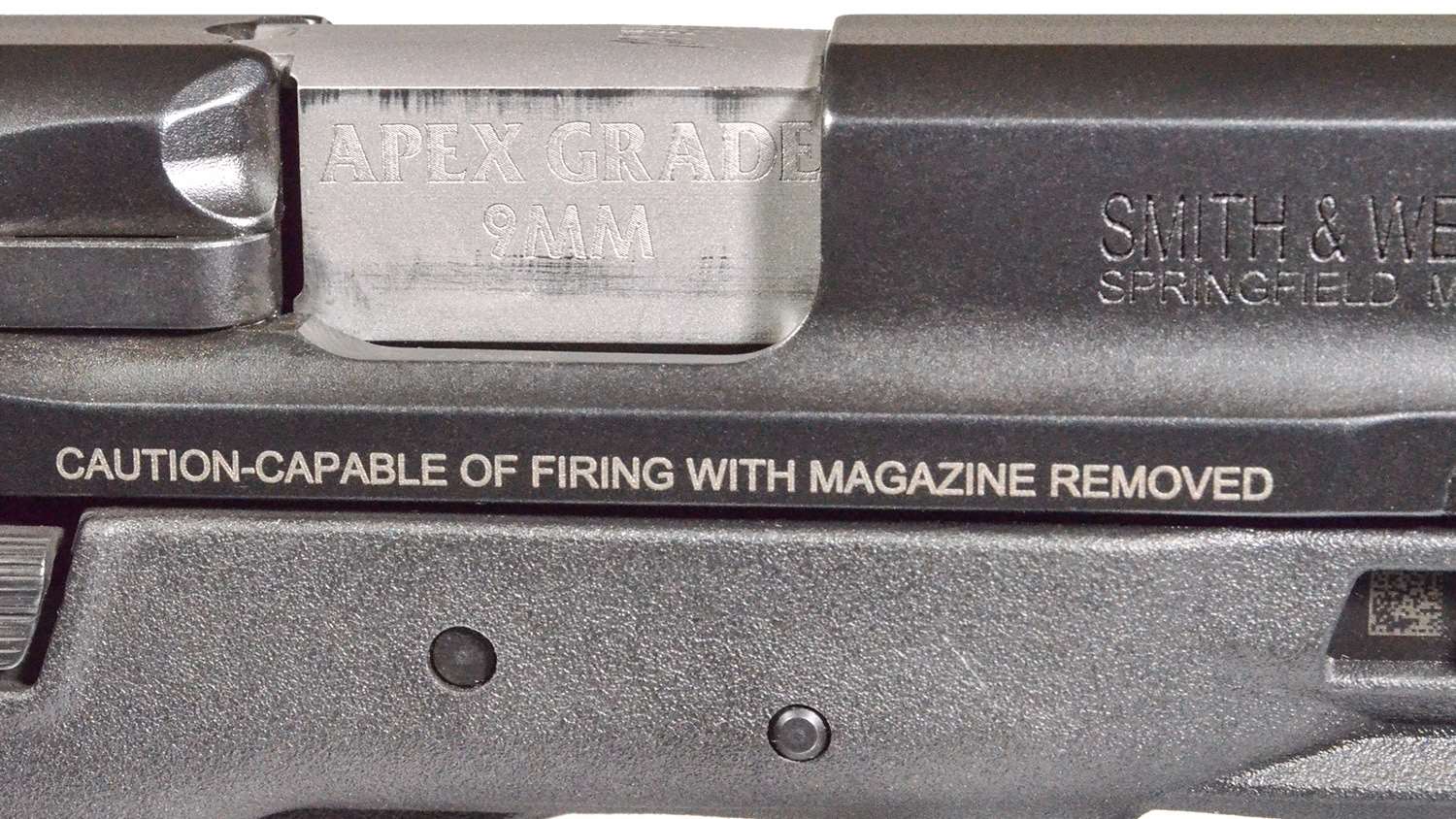
A closer look at the bottom lock-up surface showed evidence of minor contact on the pad. There was no vertical movement in the barrel when the slide was locked forward, suggesting a solid fit. But the proof of function and accuracy awaited at the range.
I slugged the new Apex barrel along with the original barrel with 0.3581-inch coated cast bullets. The S&W barrel slugged at 0.3565 inch and the Apex barrel slugged at 0.3578 inch. Both dimensions are within SAAMI specifications for a 9mm barrel groove diameter (0.355 + 0.004).
The Smith & Wesson M&P barrels are known to have short throats and handloaders have to be watchful and load their bullets a little deeper than they would for some barrels. The same is true of the Apex barrel, though this one had an even shorter throat than the S&W barrel.
For example, I can load 9mm Zero 115 JHP-conical bullets to around 1.150 inch for several of my 9mm barrels. With the original barrel, they just fit at around 1.100 inch. The Apex barrel chamber is even shorter and the maximum length that will fit is 1.073-inch. All the factory ammunition I tried fit in the Apex barrel with no problems.
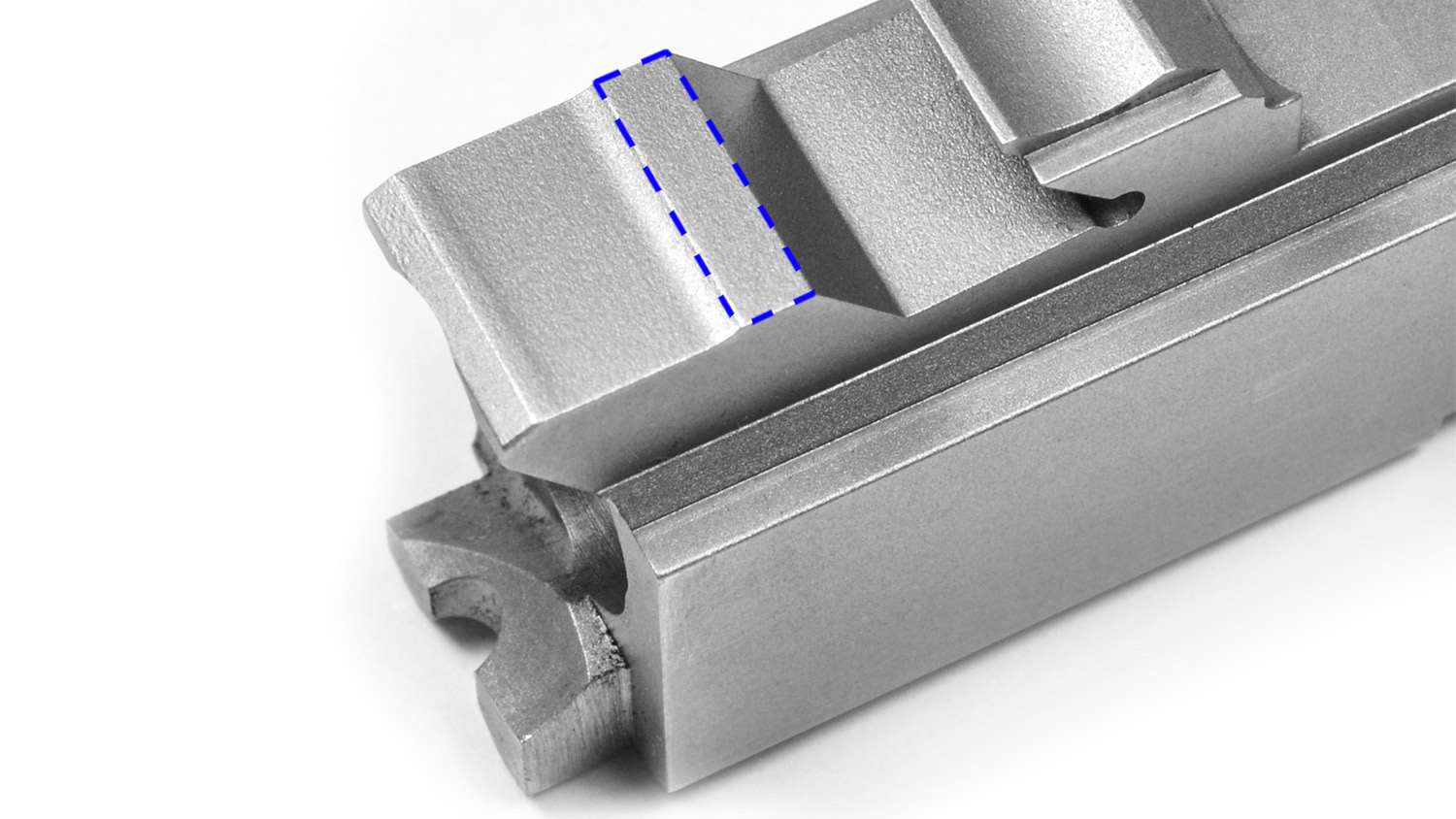
Range Results
The accuracy test compared group size at 25 yards from the Smith & Wesson and Apex barrels with the gun mounted in a Ransom Rest. I used seven loads: six factory and one handload. Groups were a single 25- or 50-shot group. Putting a large number of rounds in a single group provides a clearer picture of shot dispersion that might be missed if shooting multiple groups with the same ammunition and demonstrates how consistent the gun and/or ammunition shoots.
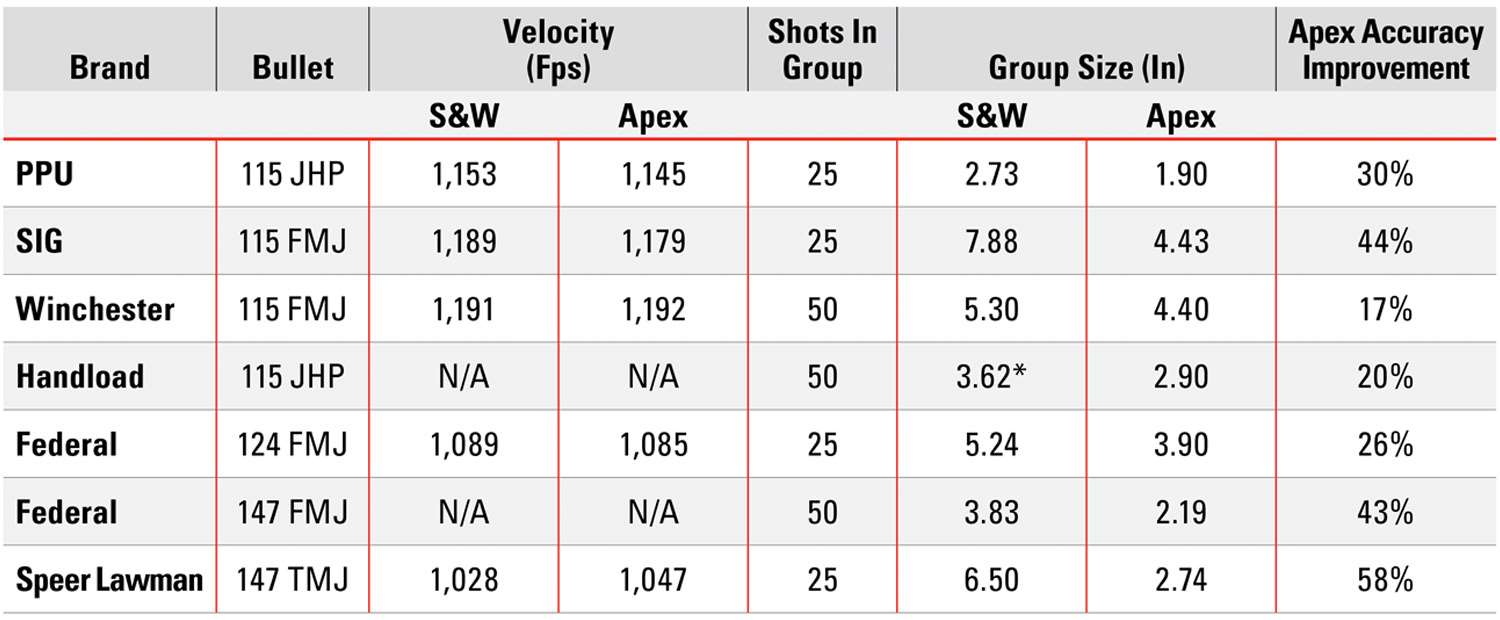
The pistol ran reliably with the Apex barrel. Whatever resistance there might have been with the snug fit did not hamper function.
As for accuracy, the Apex barrel produced obviously smaller groups with all seven loads. Group size with the Apex barrel was reduced from 17 to 58 percent of the group size produced with the S&W barrel. The average group size with all seven loads was reduced by 34 percent with the Apex. Velocity of the two barrels was nearly the same.
What about point of impact? The thing about changing barrels is that they might not point to exactly the same place. You don’t need much of a difference in fitting dimensions or bore axis to move the point of impact. This was examined by using one sheet of paper to record the point of impact from both barrels using the same ammunition.
The point of impact with the Apex barrel was about 1½-inch high and ¼-inch to the right of the POI with the original barrel. That’s not too much of a change at 25 yards.
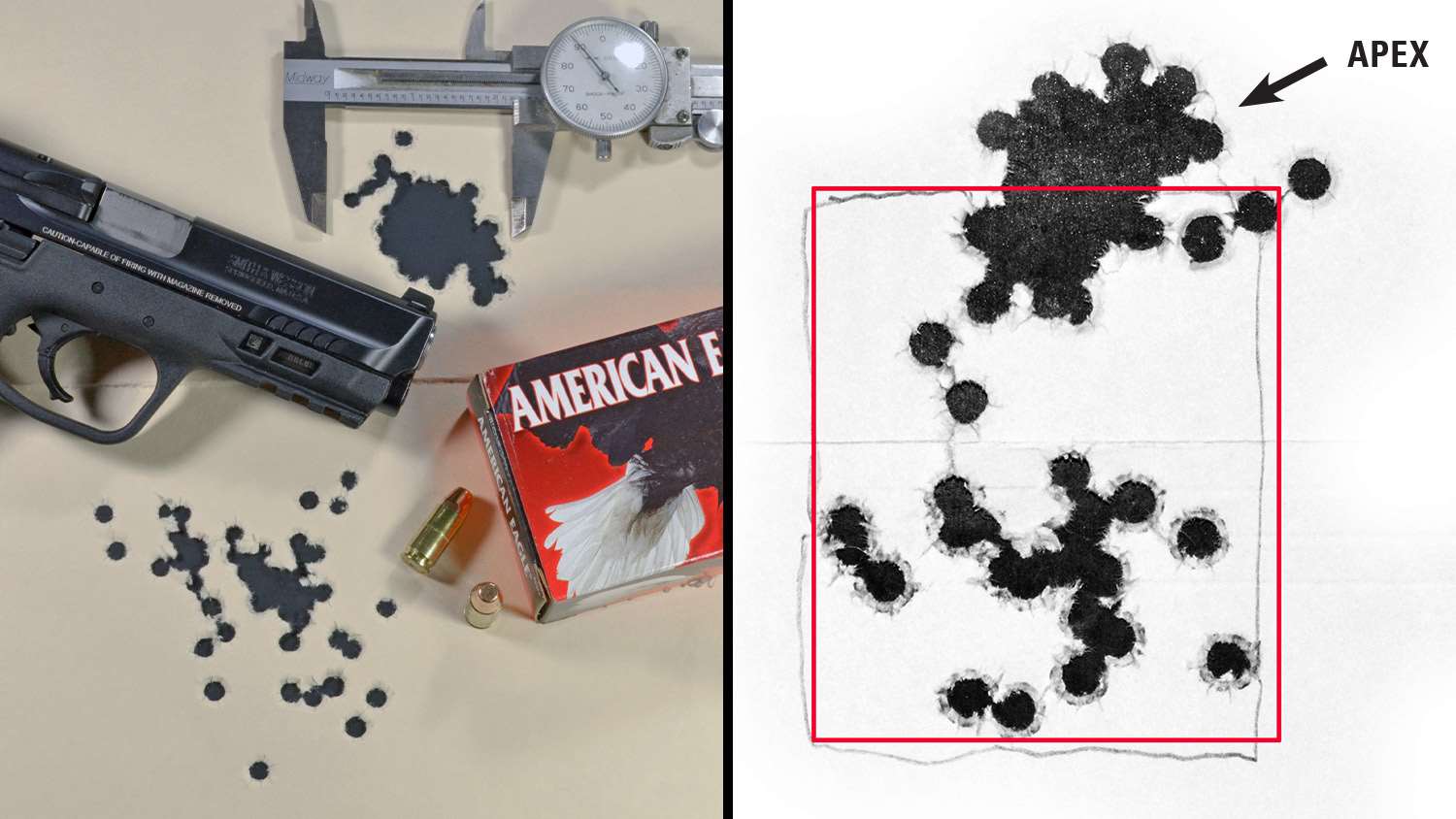
Summary
The Apex barrel made a significant improvement in accuracy with my M&P pistol. All the ammunition tested produced smaller groups with the Apex and the average group size was reduced by one-third. That’s a big overall improvement.
I did not shoot any five-shot groups like Apex does, but from watching the hits on the paper I could see several times where a five-shot string would be under 1 inch. The PPU 115-grain load put all 25 rounds into a group less than 2 inches and the Federal 147-grain FMJ load put 50 rounds in a 2.19-inch group with the Apex barrel. In fact, the Apex barrel in the M&P shoots the Federal load into a smaller group than my 1911 with a Kart barrel (50 shots in 2.37 inches, also in a Ransom Rest). That’s impressive performance for a polymer-frame pistol. I imagine that handloads could reduce group size even more with a little testing.
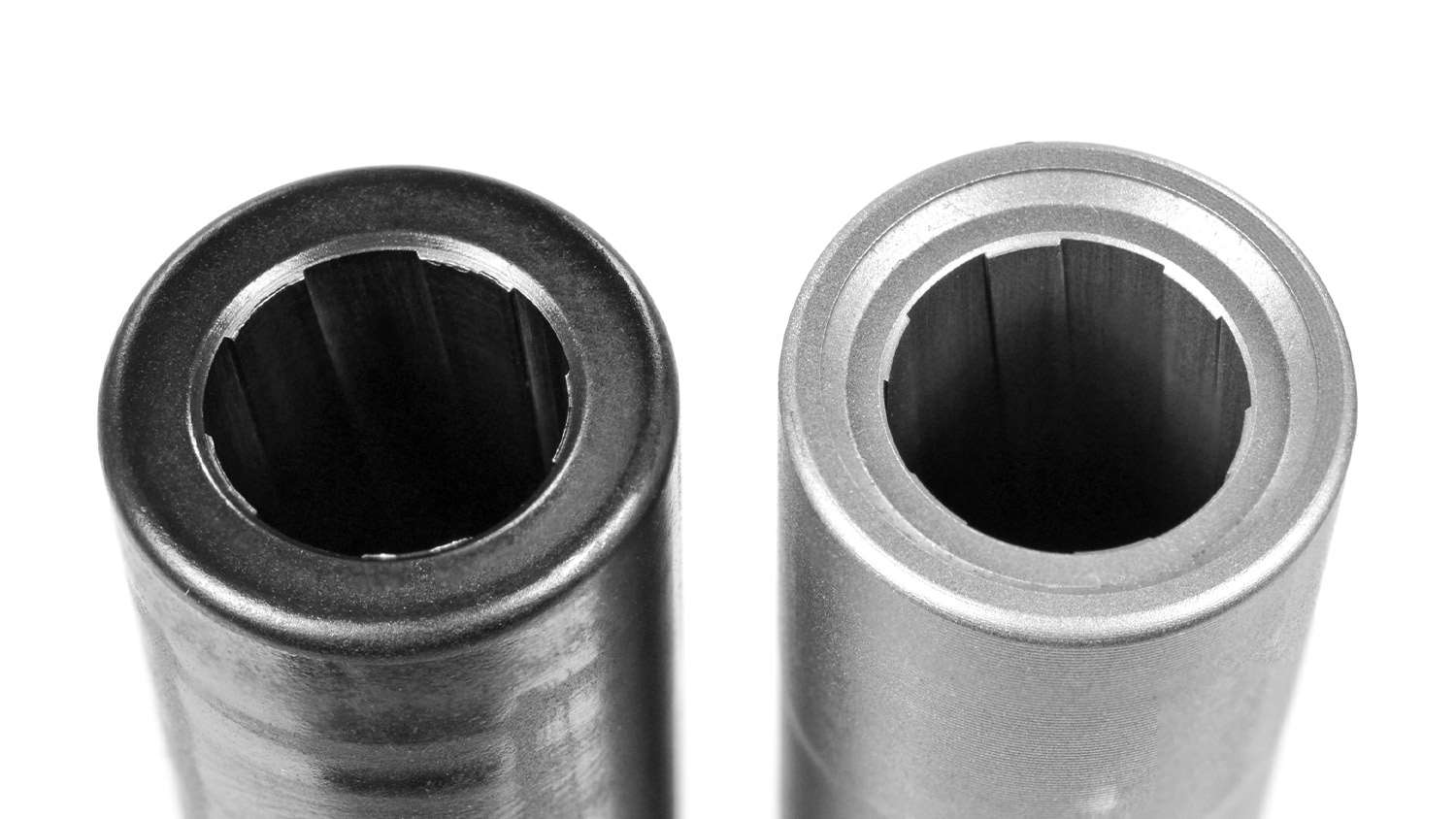
The Apex barrel shoots straight, but it requires proper fitting. If you think your M&P might benefit from an Apex Grade barrel, consider having a qualified gunsmith do the fitting. There’s no substitute for proper fitting. Even the best barrel won’t help if the fit is loose.
Apex is not currently fitting barrels as they are diverting their resources to other projects, but this could change in the future. There are two gunsmiths they recommend for fitting Apex barrels as they understand the proper fitting process. They are Georgia Firing Line and ATEi.
I was lucky and the bottom lock-up surface did not require any work for a good fit in my pistol. If you decide to go the route I did—having a gunsmith fit the barrel to the slide and do the lower lock-up surface yourself—check with the aforementioned gunsmiths about this option.
Apex Grade M&P barrel prices start at $199.95. If you want to install the barrel yourself, Apex has a jig that can aid in the fitting process. An instructional video and a PDF file on barrel installation are available here.
Read more articles by Brad Miller:
- Review: Everglades 9 Major Ammunition
- Review: Norma 9mm Competition Ammunition
- Accuracy Testing: Shortcomings Of The Five-Shot Group
- Review: Eley .38 Super Comp Ammunition
- Rimless .38 Super Brass: Everything You Need To Know
- How To Power Clean Revolver Chambers
- 38 Different 9mm Loads
- Review: Smith & Wesson 5-inch M&P M2.0 9mm
- Kaboom: The Consequences Of A Blown-Out Case
- Firing Out Of Battery?
- Heavy 9mm Luger Bullets: Everything You Need To Know
- Review: Federal Syntech Action Pistol Ammunition
- How To Use 9 Major In A Short Barrel














